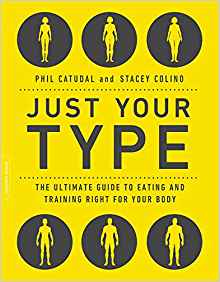Stacey Colino is the author, with Phil Catudal, of the new book Just Your Type: The Ultimate Guide to Eating and Training Right for Your Body Type. Her other books include Strong Is the New Skinny, and her work has appeared in a variety of publications, including U.S. News & World Report and Prevention. She lives in the Washington, D.C., area.
Q: How did you and Phil Catudal end up working on this book
together, and what was your collaboration process like?
A: A few years ago, I interviewed Phil for a couple of
celebrity diet/fitness articles for a national magazine and I was really
impressed with his body-type (a.k.a., somatotype) approach to getting his
celebrity clients the results they wanted. His knowledge about fitness and
physiology and his kind, compassionate, reality-based style also struck me.
At one point during a phone call, I suggested he write a
book about how to train and eat well for your body type because there wasn’t
one on the market. He said he’d love to and asked me to write it with him. The
rest is history.
Because Phil is based in LA and I’m outside DC, we had
weekly phone calls to brainstorm ideas or discuss nuanced issues or research
findings and we worked on the actual writing via e-mail, sending drafts of
chapters back and forth. Considering that we only worked together once in
person (when we both happened to be in NYC at the same time), it ended up being
a very smooth collaboration process.
Q: In the book, you describe three body types. Can you say
more about the differences among them?
A: The three primary body types are based on the size and
shape of your body, including your bone size, your relative proportion of
muscle to fat, how you respond to different forms of exercise (especially
weight training), and how your body responds to different foods (especially
carbs). How easily you gain or lose weight also comes into play.
Among the most interesting aspects I learned while working
with Phil: Most of us misclassify our body types and most of us are hybrids
(combinations of two types). That was something I’d never thought of and it
turned out to be true for me personally—I’m an ecto-mesomorph (which I never
would have imagined), because I’m on the tall side (5’9 1/2) and have slender
wrists and ankles but also the propensity to be strong and muscular with the
right training.
Q: What kind of research did you need to do to write the
book?
A: Phil is a certified personal trainer and I’m a certified
Spinning instructor and health coach so between us, we had a lot of background
knowledge about fitness and diet programs that we used as a foundation. We
built upon that by reading scientific studies about how people with different
body types respond to different types of fitness training, perform in different
sports, and respond to meals with different proportions of protein, carbs, and
fat.
We also included research about different
mental/motivational techniques that can make a difference in helping people get
the results they want. Sometimes just the way you think about or visualize
something or the way you talk to yourself (in your head) can help or hinder
your performance during a workout as well as your progress in reaching a
particular goal.
Q: What do you hope readers take away from Just Your Type?
A: I hope they’ll figure out what will help their bodies
become the healthiest versions of themselves that they can be and feel better
than they ever have.
With Just Your Type, I suspect readers will discover that
they don’t necessarily need to exercise harder or longer but smarter—in other
words, they may find that they’re not doing the right types of workouts for their
bodies. That alone is a game-changer.
HIIT (high intensity interval training) figures prominently
in Just Your Type—it’s a great way to get a huge bang for a relatively short
time investment (often just 15-20 minutes).
Q: Anything else we should know?
A: Something else that has truly impressed me about Phil: He
is a childhood cancer survivor—he won a five-year battle against childhood
leukemia. His father died from cancer when Phil was a teenager and his brother
developed cancer in his early 20s.
These experiences inspired Phil’s interest in fitness. After
losing his dad, he dedicated himself to getting super fit and healthy—and it
became his mission to help other people do the same. Because he does it with a
gentle, compassionate style, he makes you want to work hard to take good care
of yourself and become a better person. He leads by example.
Q: What are you working on now?
A: I’m currently collaborating on two non-fiction books. One
is with Dr. Shanna Swan and it's about how our modern world is threatening
sperm counts, sexual development and function, and the future of the human
race.
The other is with Dr. Lise Van Susteren about what we’re
calling “emotional inflammation”—that nameless angst or dread, anticipatory
anxiety, and state of hyper-reactivity that so many of us are living with,
these days—as well as how to calm it and restore your emotional equilibrium.
Both will be published in 2020.
--Interview with Deborah Kalb


No comments:
Post a Comment